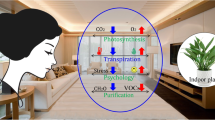Abstract
The thermal-environment characteristics of the existing forced-convection cooling system were compared with those of the convective cooling system, which combined the radiant-floor cooling system using floor-heating panel typically applied to apartments in South Korea with the forced-convection cooling system using improved fan coil unit. The subjective warm/cool-feeling responses to the combined radiant-floor and convective cooling system in the questionnaire survey conducted among the test subjects were analyzed to establish the basic data for the combined cooling system. The results show that in the thermal-equilibrium condition, the vertical air temperature difference in the model living room is larger in the forced-convection-cooling condition. Most of the subjects feel a proper warm/cool feeling on their entire body, but they feel colder on the foot and lower body in the combined-cooling condition.
Similar content being viewed by others
References
SONG D, KATO S. Radiational panel cooling system with continuous natural cross ventilation for hot and humid regions [J]. Energy and Buildings, 2004, 36: 1273–1280.
SONG D, KIM T, SONG S, HWANG S, LEIGH S B. Performance evaluation of a radiant floor cooling system integrated with dehumidified ventilation [J]. Applied Thermal Engineering, 2008, 28: 1299–1311.
LIM J H, JO J H, KIM Y Y, YEO M S, KIM K W. Application of the control methods for radiant floor cooling system in residential buildings [J]. Building and Environment, 2006, 41: 60–73.
SONG G S. Buttock responses to contact with finishing materials over the ONDOL floor heating system in Korea [J]. Energy and Buildings, 2005, 37: 65–75.
SATTARI S, FARHANIEH B. A parametric study on radiant floor heating system performance [J]. Renewable Energy, 2006, 31: 1617–1626.
YEO M S, YANG I H, KIM K W. Historical changes and recent energy saving potential of residential heating in Korea [J]. Energy and Buildings, 2003, 35(7): 715–727.
SONG D, KIM T, SONG S, HWANG S, LEIGH S B. Performance evaluation of a radiant floor cooling system integrated with dehumidified ventilation [J]. Applied Thermal Engineering, 2008, 28: 1299–1311
RYU S R, RHEE K N, YEO M S, KIM K W. Strategies for flow rate balancing in radiant floor heating systems [J]. Building Research & Information, 2008, 36(6): 625–637.
HONG C H. Thermal performance evaluation for radiant heating of apartment houses [D]. Graduate School of Engineering, 1996: 56.
Society of Air-conditioning and Refrigerating Engineers of Korea. Standard weather data [R]. 2010: 32–45.
GU S Y. Application of radiant floor cooling with the ondol system to apartment houses [D]. Seoul University, 2000: 27–28.
WILLIAM K, TAO Y. Mechanical and electrical systems in buildings [M]. 4th edition. Prentice Hall, 2008: 40–58.
JIN Xing, ZHANG Xiao-song, LUO Ya-jun. A calculation method for the floor surface temperature in radiant floor system [J]. Energy and Buildings, 2010, 42: 1753–1758.
LIN K, ZHANG Y, XU X, DI H, YANG R, QIN P. Modeling and simulation of underfloor electric heating system with shape-stabilized PCM plates [J]. Building and Environment, 2004, 39: 1427–1434.
LIM J H, JO J H, KIM Y Y, YEO M S, KIM K W. Application of the control methods for radiant floor cooling system in residential buildings [J]. Building and Environment, 2006, 41: 60–73.
TIAN Z, LOVE J A, Energy performance optimization of radiant slab cooling using building simulation and field measurements [J]. Energy and Buildings, 2009, 41: 320–330.
TIAN Z, LOVE J A. A field study of occupant thermal comfort and thermal environments with radiant slab cooling [J]. Building and Environment, 2008, 43(10): 1658–1670.
LEIGH S B. An experimental approach for evaluating control strategies of hydronic radiant floor heating systems [D]. AnnArbor, MI: University of Michigan, 1991.
Author information
Authors and Affiliations
Corresponding author
Additional information
Received date: Project(NRF-2013RIA2A1A01014020) supported by the National Research Foundation of Korea
Rights and permissions
About this article
Cite this article
Lee, KG., Hong, WH. Thermal-environment characteristics and comfort of combined radiant-floor (Korean heating system ondol) and convective cooling system. J. Cent. South Univ. 20, 3589–3603 (2013). https://doi.org/10.1007/s11771-013-1885-0
Received:
Accepted:
Published:
Issue Date:
DOI: https://doi.org/10.1007/s11771-013-1885-0




